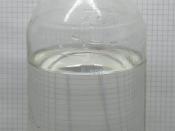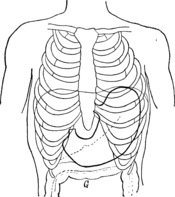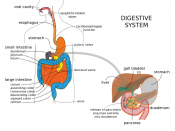Digestion
A burger is broken down mechanically by biting into it. The food in the mouth sets off salivary glands that secrete salivary amylase, which breaks down amylase in the burger. When the food is broken down enough, the tongue shapes the food in a bolus, or a ball. The bolus is pushed back to the pharynx at the back of the throat. The food stimulates the opening of the flap so the good goes down the esophagus, rather than the windpipe. Because of peristalsis, rhythmic waves created by muscles in the throat, the food slides easily down the digestive tract. Salivary amylase continues to break down the starch all the way down the esophagus.
When the burger reaches the stomach, the epithelium, or stomach wall, secretes gastric juice which has a very high concentration of hydrochloric acid and breaks up the burger. In the gastric juice is also an enzyme that hydrolyzes proteins called pepsin.
This pepsin starts out as the inactive pepsinogen, and is activated by hydrochloric acid in the epithelium. After this, the burger is churned in the stomach and becomes chyme, or vomit.
From the stomach, the burger goes through the pyloric sphincter and into the small intestine. In the first 25 cm of the small intestine, the food goes through the duodenum, a place where pancreatic enzymes and bile from the live are stored. Bile, along with the enzyme lipase, breaks down fat while the enzyme nuclease breaks down nucleic acids and various enzymes, such as trypsins and peptidases, break down the proteins. These substances are called by hormones which act based on stimuli received, such as the food in the duodenum. Absorption also occurs in the small intestine because of its large surface area. It has a very large surface area because...


